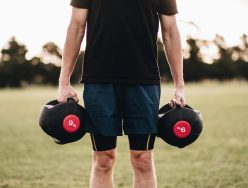The shoulder is a complex joint involved with everyday activities such as reaching and sport specific movements. Evidenced based research and my clinic experience as a physical therapist, supports that shoulder impingement is a common movement dysfunction seen in men. This article will review the following about shoulder impingement:
• Pathophysiology
• Common signs and symptoms and contributing factors
• Physical therapy management
• Program design
• Exercises that are contraindicated with rationale
Pathophysiology/mechanism of injury: Shoulder impingement(SI) is the mechanism in which the supraspinatus tendon of the rotator cuff becomes impinged as it passes through a narrow bony space called the subacromial space. With repetitive movement, the supraspinatus the tendon can become irritated and inflamed. SI can also be caused by a decrease in posterior capsule mobility and weakness of capulothoracic musculature. Evidenced based research has shown that shoulder impingement is a common condition believed to contribute to the development or progression of rotator cuff disease(Ludewig, P. 2011)
• Decrease in subacromial space comprises the supraspinatus tendon, predisposing it to micro tears leading to degeneration and ultimately tearing.
• Tightness of the posterior capsule causes the humerus to migrate anterosuperior into the AC joint.
• Weakness of scapulothoracic muscles leads to abnormal positioning of the scapula.
Common signs and symptoms: Clients will complain typically of pain in the front of the shoulder, described as deep, dull ache with stiffness. Reaching overhead and behind one’s back will elicit pain.

Figure 1. Painful arc
capsule are some contributing factors. Per the research, the development of SI has been correlated to abnormal muscle activation. Specifically, those with SI, present with the overactive upper trapezius and underactive lower trapezius muscles (Chester, R., et al. 2010).
Physical therapy management:
The goal of physical therapy is to restore scapular mobility, followed with stretching to restore full range of motion (figure 2). Strengthening focuses on targeting the weaker upper posterior musculature that includes rhomboids, low trapezius, external rotators and serratus anterior muscles. Then the patient is taught scapular stabilization and dynamic strengthening exercises.

Figure 2. Manual therapy
by a physical therapist on
shoulder
Program design and exercise prescription for the impingement client
Once discharged from physical therapy, transitioning to the gym should be simple, and based on science, not guessing. The focus on post rehabilitation training is to strengthen the scapular stabilizers (rhomboids, low trapezius, posterior deltoid and external rotators) and posterior shoulder. Core strengthening should progress from static to dynamic exercises.

Figure 3. Posterior capsule stretching Figure 4. Low trapezius strengthening Figure 5. Mid row exercise
Upper body exercises that are safe based on biomechanics include:
• Low trapezius pulls downs (figure 4) with cable standing or tubing, depresses and retracts the scapula, unloading the anterior shoulder, improving posture and posterior stability.
• Seated mid row, one arm dumbbell row, seated reverse flies (posterior deltoid) strengthens the weaker phasic muscles of the posterior chain.
• External rotation with cable, seated reverse flyes, seated dumbbell side raises.
• Core strengthening exercises that are safe include but not limited to; standing trunk rotation with cable/tubing, diagonal with cable tandem in place lunge, planks, planks with a ball, trunk rotation with a forward lunge.
Exercises that are contraindicated include with rationale:
• Seated dumbbell shoulder press (creates an excessive load to the medial deltoid).
• Lat pulls downs behind the head (at end or range places greatest stress on all glenohumeral ligaments as well as on the labrum).
• Upright row (at end of range-shoulder is maximally internally rotated which places stress on all glenohumeral ligaments, labrum, and connective tissue)
Summary:
Shoulder impingement is a common shoulder condition that a fitness professional may encounter. Understanding the anatomy, biomechanics and proper program design with evidenced based training strategies, will provide you with a better understanding to work with clients.
Was this Article Helpful?
If this article was helpful to you, please consider linking this article to your own blog or sharing this through the social buttons below. You will also find other great articles at “Corrective Exercise And Rehabilitation“.
- 4shares
- 2Facebook
- 0Twitter
- 2Pinterest
- 0LinkedIn
Chris Gellert
Latest posts by Chris Gellert
- Training the Impingement Client - August 16, 2016
- Working with the older client Part 1 - May 25, 2016
- The Cervical Spine – Understanding The Science Behind Both Movement And Dysfunction - December 10, 2014


















